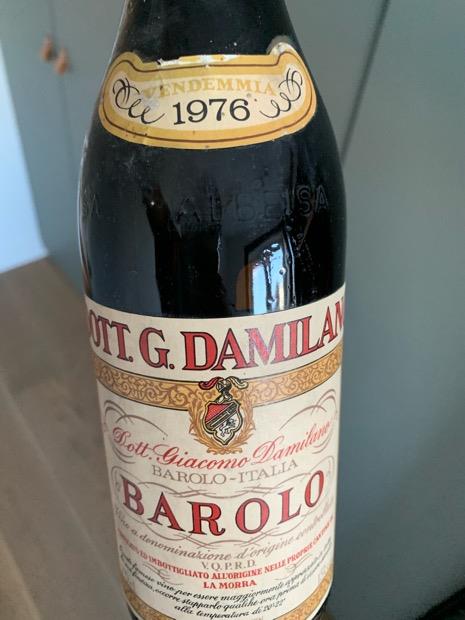
External search
Google (images)
Wine Advocate
Wine Spectator
Burghound
Wine-Searcher
Vintages
2019
2018
2017
2016
2015
2014
2013
2012
2011
2010
2009
2008
2007
2006
2005
2004
2003
2002
2001
2000
Show more
From this producer
Show all wines
All tasting notes
|
| Drinking Windows and Values |
| Community Tasting History |
| Community Tasting Notes (average 92.5 pts. and median of 92 pts. in 4 notes) - hiding notes with no text | | | Tasted by pnf on 1/25/2019: Peat, dates, leather. Dark, almost bloody red. (1477 views) | | | Tasted by GuWin on 8/12/2015 & rated 92 points: Meget mørk, tett farge, brunlig kant. Flott nese; intens duft av morkent trevirke, underskog, tørkede roser, søtlig preg av karamell og toffee, modne plommer - kontinuerlig utvikling i glasset, og nye dufter dukker opp ved hver 'nyhelt'. Kirsebær og marsipan dukker opp etter et par timer...
Duften gir løfter om en svær vin, og det får man; meget fyldig, konsentrert smak med godt utviklede og nyanserte toner som kan oppfattes som både rustikke, parfymerte og leskende. Syren fortjener et avsnitt for seg selv, den er så ekstremt ren og stram at man må knipe sammen øynene - men balanseres av en korrekt dose moden frukt og en voksen - nesten voldsom - tanninstruktur. Ettersmaken varer i minutter, og alt er godt integrert.
Nytt bekjentskap, stor vin! (2055 views) | | | Tasted by pasquali on 12/31/2008: Opened at 2pm (used the pump opener), poured through a filter cap into a duck decanter. Drank around 9pm. Head-to-head with 1971 Cantina Vinicola Piemontese. Absolutely stunning. Incredible smell, as if one had combined a nice, 15-year-old Amarone, with a Islay Scotch (Lagavulin). Got better and better during the night. Taste was good (delicate) as well, stonger than the Cantina Vinicola one. Had an extremely long aftertaste. Smell of dried cherry, raisins, peat, tar, leather, spices. The smell was absolutely inebriating. Incredible! (3235 views) | | | Tasted by Barbara B on 6/29/2007 & rated 93 points: Served blind by Antonio at La Vecchia Bottega in the Ghetto.
Curious labelling -- says Barbaresco, then Barolo Piemonte, then Barbaresco again, and lastly La Morra.
Brick red core, orange rim, fine sediment in suspension; has that Nebbiolo look. On nose, fully developed, intense feral, earth, toasted/roasted nuts, dried fruit, brandy. On palate, rich flavour, sapid, umami; medium body, medium alcohol (label 13%) medium acidity, smooth/mild tannins with very slight bitterness on the finish. Very long and complex, beautifully balanced. (2452 views) |
| Damilano Producer Website
U.S. Importer (Addt'l Info)
The origins of the Damilano farming company date back to over a century ago, when Giuseppe Borgogno, the great-grandfather of the current owners, started to grow and make wine from his own grapes. This tradition was kept up by Giacomo Damilano, the founder's son-in-law, together with his children until it passed on to his four grandchildren: Guido, Margherita, Paolo and Mario, who very attentively manage their forefathers' land today. The wines produced are renowned for their upright style and the estate is widely appreciated thanks to the strictness and passion that accompany all of the company's activities.NebbioloNebbiolo is a red grape indigenous to the Piedmont region of Italy in the Northwest. The grape can also be found in other parts of the world, though they are not as respected.
Nebbiolo is often considered the "king of red wines," as it is the grape of the famed wines of Barolo DOCG, Barbaresco DOCG, and Roero DOCG. It is known for high tannins and acidity, but with a distinct finesse. When grown on clay, Nebbiolo can be very powerful, tannic, and require long aging periods to reach its full potential. When grown on sand, the grape exhibits a more approachable body with more elegant fruit and less tannins, but still has high aging potential.
"Nebbiolo" is named for the Italian word, "nebbia", which means "fog", in Italian and rightfully so since there is generally a lot of fog in the foothills of Piedmont during harvest.
Nebbiolo is a late-ripening variety that does best in a continental climate that boasts moderate summers and long autumns. In Piedmont, Nebbiolo is normally harvested in October.
More links:
Varietal character (Appellation America) | Nebbiolo on CellarTrackerItaly Italian Wines (ItalianMade.com, The Italian Trade Commission) | Italian Wine Guide on the WineDoctorPiedmont Vignaioli Piemontesi (Italian only)
On weinlagen-infoLanghe Consorzio di Tutela Barolo Barbaresco Alba Langhe e Roero | Union of Producers of Albese Wines (Albeisa)BaroloRegional History:
The wines of Piedmont are noted as far back as Pliny's Natural History. Due to geographic and political isolation, Piedmont was without a natural port for most of its history, which made exportation treacherous and expensive. This left the Piedmontese with little incentive to expand production. Sixteenth-century records show a mere 14% of the Bassa Langa under vine -- most of that low-lying and farmed polyculturally. In the nineteenth century the Marchesa Falletti, a frenchwoman by birth, brought eonologist Louis Oudart from Champagne to create the first dry wines in Piemonte. Along with work in experimental vineyards at Castello Grinzane conducted by Camilo Cavour -- later Conte di Cavour, leader of the Risorgimento and first Prime Minister of Italy -- this was the birth of modern wine in the Piedmont. At the heart of the region and her reputation are Alba and the Langhe Hills. This series of weathered outcroppings south of the Tanaro River is of maritime origin and composed mainly of limestone, sand and clay, known as terra bianca. In these soils -located mainly around the towns of Barolo and Barbaresco -- the ancient allobrogica, now Nebbiolo, achieves its renowned fineness and power.
map of Barolo DOCG
An interesting thread on Traditional vs. Modern Barolo producers:
https://www.wineberserkers.com/forum/viewtopic.php?f=1&t=106291 |
|




